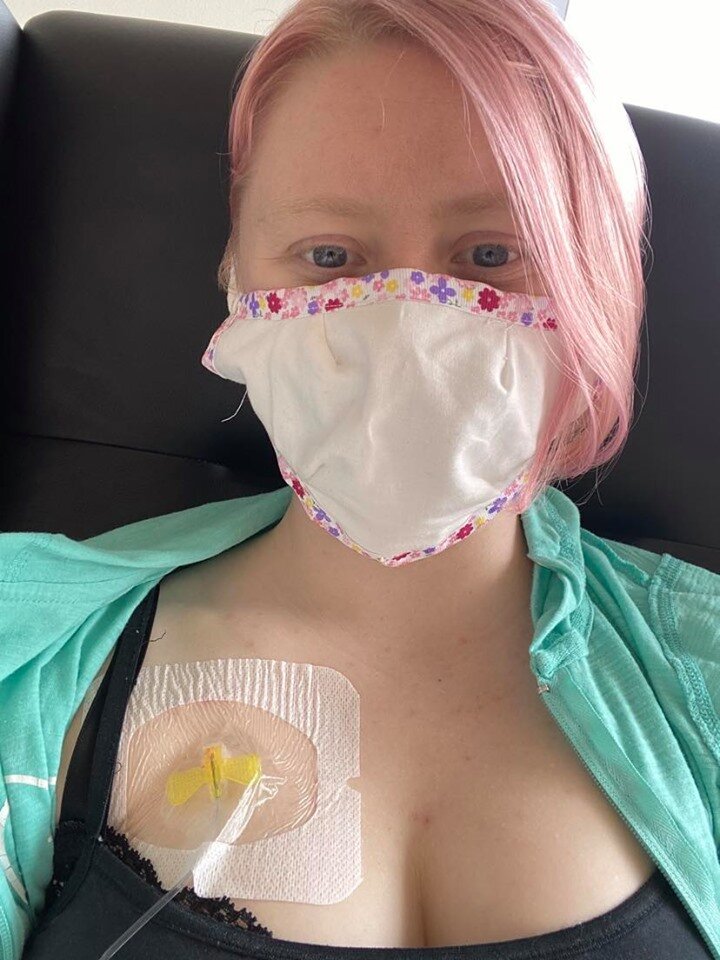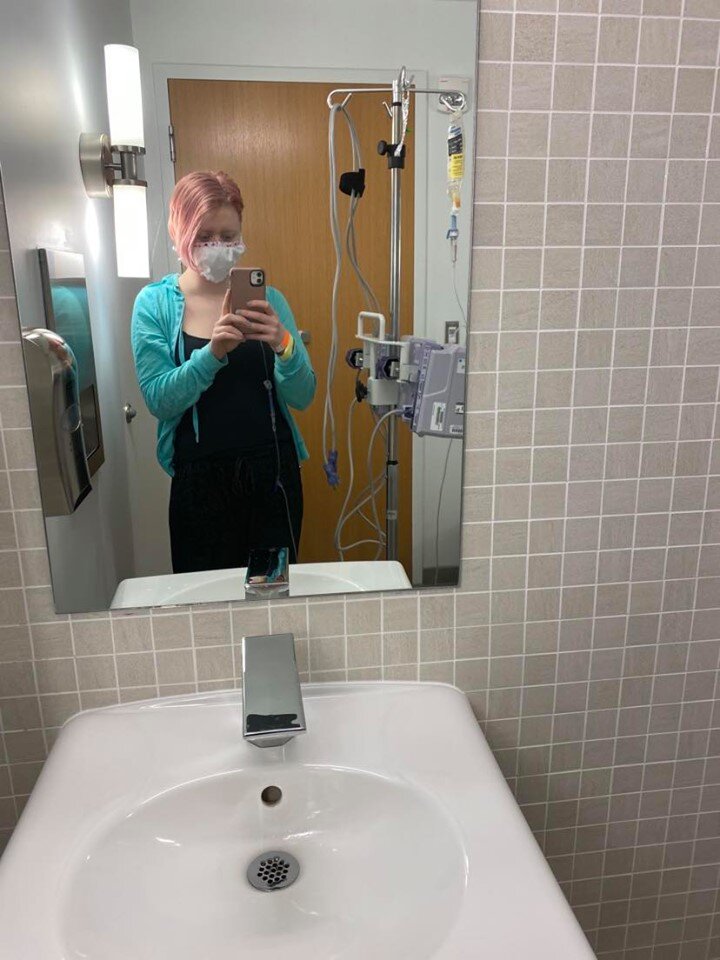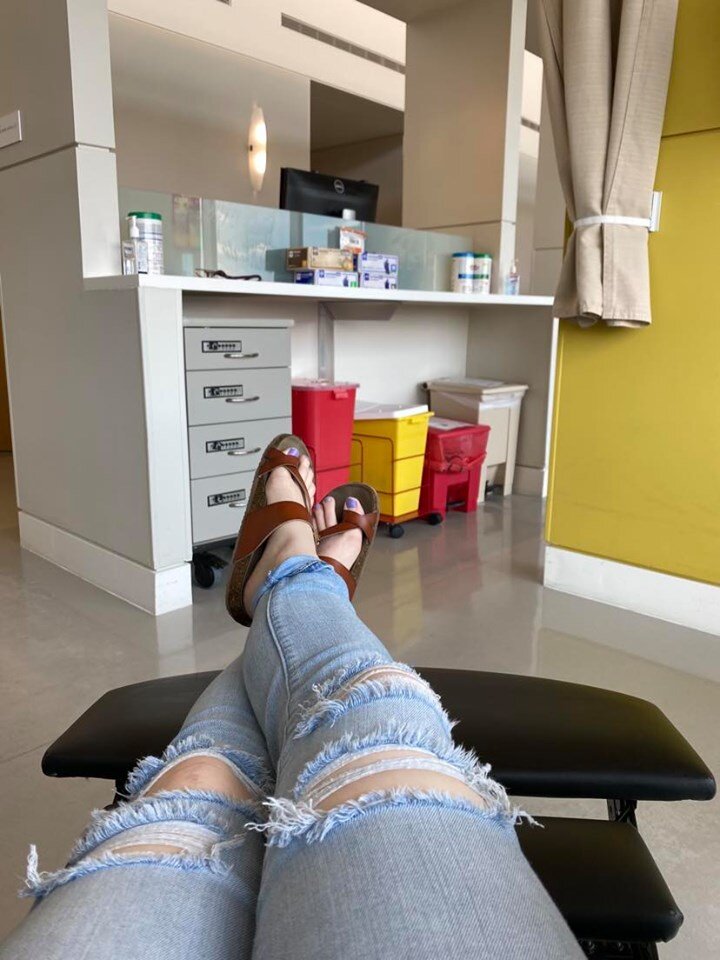Baby’s First Chemo
To someone who doesn’t think about cancer much, chemotherapy seems like a pretty straight forward concept. It’s a treatment used for cancer patients, that makes them vomit and lose their hair. Right? As it turns out, it’s a little bit more complicated than that - there are about as many different types of chemo as there are different types of cancer. The chemo that is most commonly used for Hodgkin’s Lymphoma is a treatment regimen called ABVD, which is an acronym for four fancy sounding drugs that I can barely say and certainly don’t know how to spell off the top of my head. Without doing any research or referring to my patient information handouts, I will tell you about them.
A - A drug
(Pronounced Adrio-my-O-sin) Bright orange, makes you lose your hair and can cause mouth sores. This medicine is injected by hand by a nurse over the course of about 15 minutes. While the nurses are administering the chemo, you have to eat something cold to restrict the blood vessels in your mouth and prevent A-drug from reaching them and causing sores. At my first infusion, this meant eating surprise ice cream and popsicles at 9 am (a great cancer perk which no one talks about).B - Bleomycin
I know this drug's name because it the one that my doctors won't stop talking about, since it's "toxic" and could "cause serious damage to my lungs". This one is also hand injected by a nurse with a syringe over a 10 minute period. My doctors want to limit my exposure to this drug, so we are thinking of dropping it after my second chemo cycle* (think late-July). You know - because we like my lungs.* a cycle, in my case, is 28 days, with one treatment on day 1 and another on day 15. V - V Drug
I honestly don't remember much about this drug except that it starts with a V. This one is given through an IV drip over ten minutes. D - D Drug
Makes it easier for you to get sun burnt. As a person who is naturally very prone to sunburn, and who loves summer and going outside, I find this one to be unnecessarily rude. It is given for about an hour using an IV drip. The different drugs attack the cancer cells at different stages of their life cycles. This multifaceted approach kills the cancer faster than any one drug alone. All of the medicines in my chemo regimen are given to me intravenously through a small device that is implanted in my chest, called a port. Before my treatment began, a surgeon placed the port underneath the skin on the right side of my upper chest. The port is made of a flat landing site where the nurse injects a needle and a small rubber tube that runs through the vein leading to my heart. It is meant to protect my blood vessels from the chemotherapy drugs which can be very toxic and cause irritation at the injection sight.
In general, chemo works by attacking the fast growing cells in your body. That means killing cancer cells, but it also means killing other cells in your body that do helpful things like help you to digest your food, fight diseases, or sprout hairs. Therefore, in the process of killing your cancer, the chemo causes some collateral damage. Some of the common side effects for ABVD are nausea, fatigue, constipation, mouth sores, hair loss, loss of appetite and suppressed immune-system. The last one is a real bummer, considering there’s a life threatening respiratory disease going around. Womp.
I had my first chemotherapy on May 29th, and I just had my third session yesterday. So far, I have been tolerating the treatment pretty well. My biggest symptoms have been fatigue, heartburn, and some painful mouth sensitivity. I have also had some nausea but so far I have not thrown up (knock on wood).
The chemotherapies are so incredibly strong and toxic, that for several days after your infusion, you are supposed to closed-lid, double-flush the toilet and clean up any bodily fluids with bleach to protect other people from being exposed.
I left my first infusion feeling very groggy and out of it, and went to my sister’s apartment in Lancaster, where I waited for my mom to pick me up. When I got there, I immediately fell asleep for about 4 hours, and went to sleep again as soon as I arrived to my parent’s house.
That night, I didn’t sleep well. Waking up every hour or so to pee, and lying awake thinking about the acid feeling in my stomach and my scratchy throat, wondering if they were the seeds of nausea and mouth sores, waiting to burst forth. I felt radioactive and worried about my noxious bodily fluids, wondering how they might start erupting at and around my loved ones. I woke up early, because sleeping any more felt futile, and I sat on the steps of my front porch, listening to the dawn chorus of birds.
I had ups and downs over the next few days, mostly battling nausea and exhaustion. But overall, I felt better than expected. On day three, I started developing extreme sensitivity in my mouth and every time I tried to eat something, my salivary glands would burn and water, like someone was squeezing a lemon into microscopic cuts all over my mouth.
I also had an aching pain in my jaw that spread out to my ear canals.
By days five and six, I was starting to feel almost normal again and soon felt comfortable enough to go back to my own apartment and take care of myself. Before I knew it, two weeks had passed and it was time for my seconds treatment, which played out very similarly to the first, except that I noticed my hair was starting to shed much more quickly than usual. I started using a serum on my eyebrows and eyelashes which is meant to prevent them from falling out and is sold at the cancer center’s Image Recovery Center.
Another side-effect that I experienced was low white-blood-cell count, and my doctors advised me to be extra cautious about spending time with other people and to make sure I was talking precautions to avoid exposure to diseases, especially COVID-19. To improve my white-blood-cell count, they also put me on an injection called Nivestym which boosts your immune system by telling your bones to produce more white-blood-cells.
Even through the uncomfortable symptoms, I feel pretty lucky that I am able to manage most days. I have also definitely noticed that the tumors in my neck have gotten considerably smaller and continue to shrink with every session. After my second treatment, my left collar bone was finally visible again after several months of being completely obscured by the mass in my neck and today waking up after the third treatment, my neck tumor is almost undetectable.
After my next infusion, I will get another PET scan to see how well the treatment is working and to decide whether or not we will drop the Bleomycin for the remainder of my chemotherapy. With three treatments down and nine to go, I know that this is the only the beginning and that I will have to tap into my inner perseverance to stay mentally and physically strong, but overall, I am feeling very positive and thankful for all of the support from friends and family.
I am also feeling ready for a nap. Since I have been awake for almost 3 hours and killing cancer is exhausting work.




